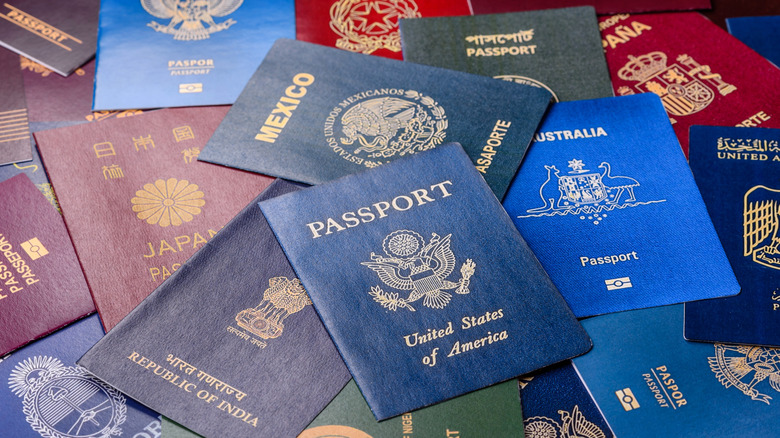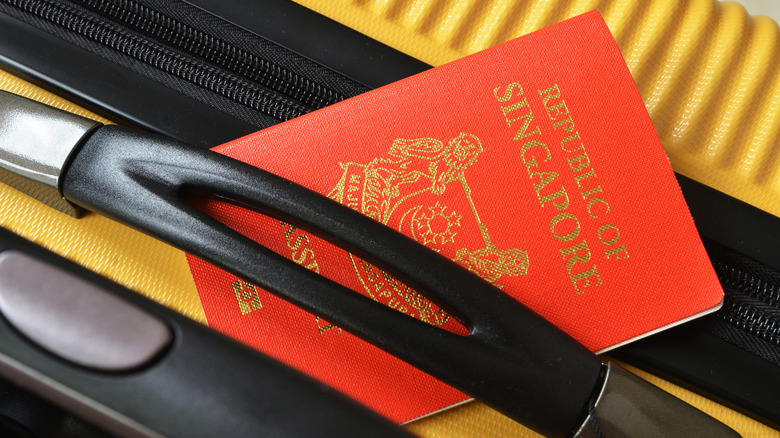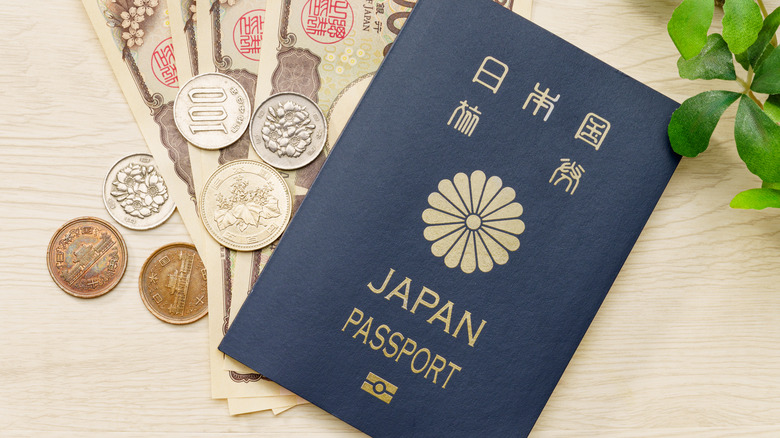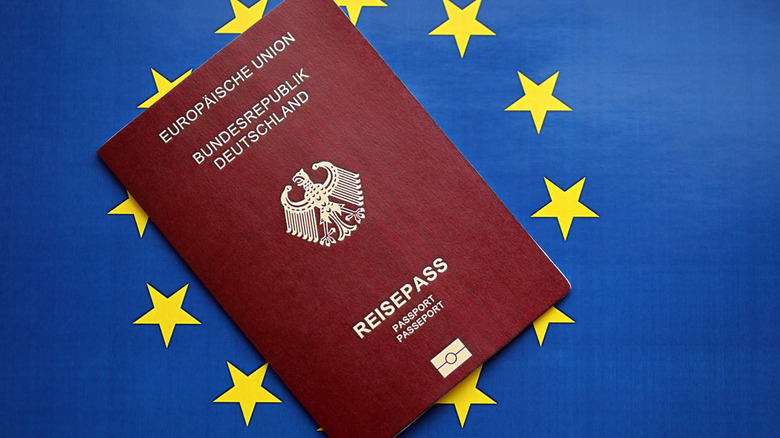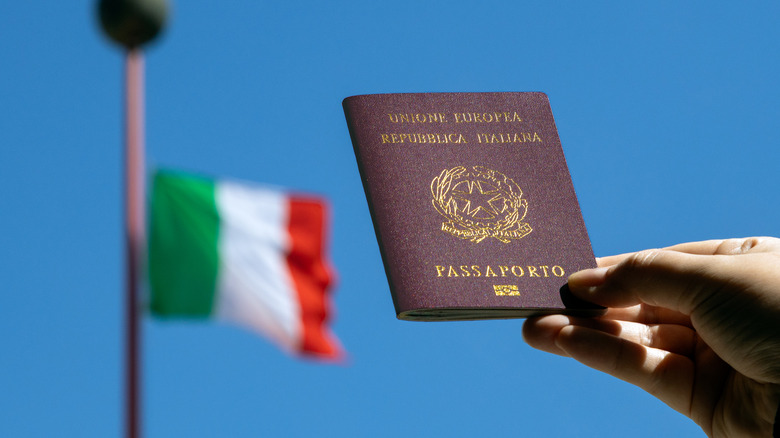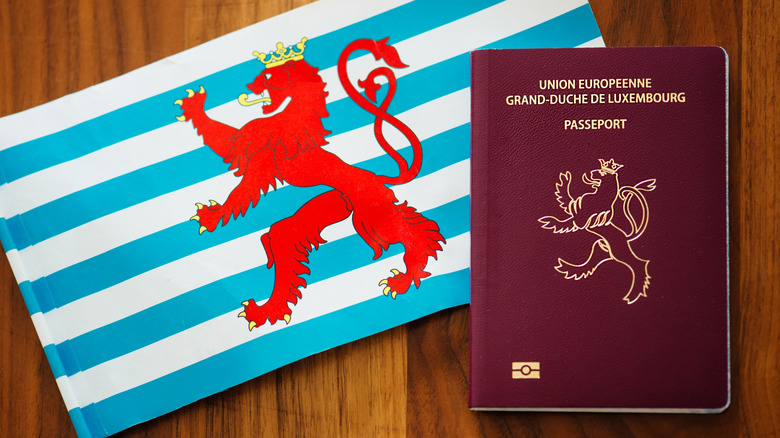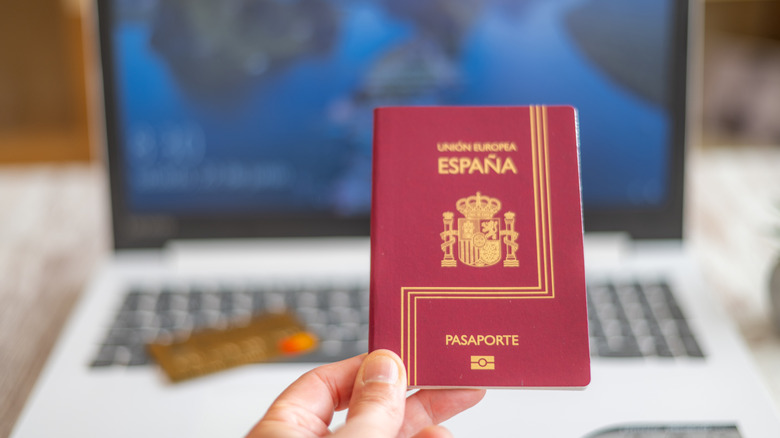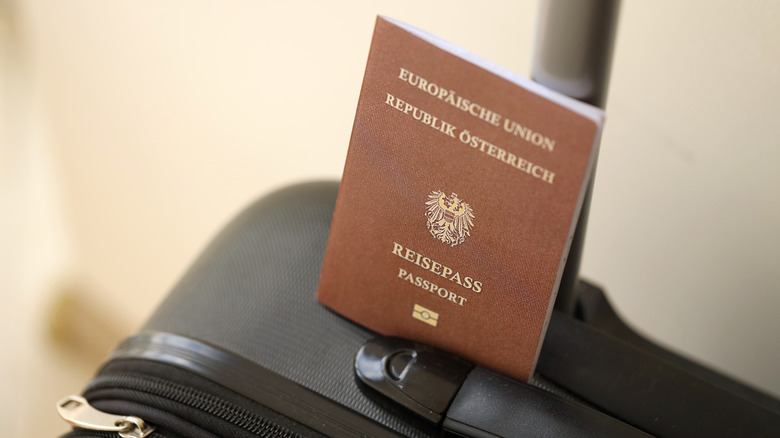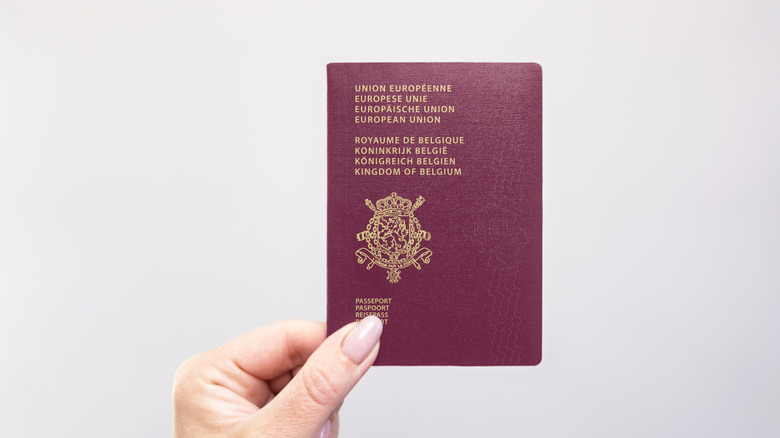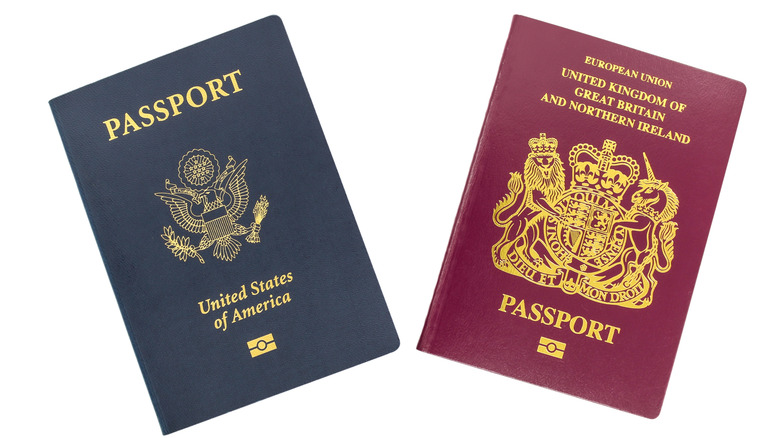The 10 Most Powerful Passports In The World In 2025
In a world that's more connected than ever, a passport is an indispensable tool. Not only is it a handy (and necessary) item to have in your pocket on vacation day, but it is also a symbol of your country's freedom and privileges. There are almost 200 recognized countries in the world, and a far greater number of those than you'd assume are severely limited in their movements.
Each year, the Henley Passport Index ranks the most powerful passports in the world, charting the number of countries each nationality can visit without a visa. Year on year (and 2025 is no different), Asia and Europe dominate the rankings, from super-powerful city-states to strategically aligned micronations. Interestingly, the Henley report highlights 227 potential destinations, as it includes overseas territories and other more complex designations — just in case you're confused about the numbers.
At the bottom of the list, many nations find themselves on the receiving end of countless bureaucratic roadblocks, rendering true mobility almost impossible. The rankings may make for an interesting read, but, more than anything else, they're indicative of the channels of power that make the world spin. These are the world's most powerful passports, and how they ended up at the top. Just remember, whatever country you're from, check the back of your passport for blank pages before heading to the airport, or it'll be useless.
Singapore (193 destinations)
Singapore successfully clung onto its number one spot thanks to some smart diplomacy and a trusted global reputation. The tiny city-state has positioned (and marketed) itself as the crossroads of the world for decades, honing its pro-business eco-systems and building one of the most affluent places on the planet. Its success on the international business front has made diplomacy easy. The Lion City has established unilateral and bilateral agreements with many countries, bolstered by the role it's likely to play in many nations' trade.
A high safety rating also helps in these situations. While it feels unfair or maybe even prejudiced to require more from citizens of "unsafe" or "high-risk" countries, there is logic in allowing easier passage to affluent countries with low levels of crime and danger. In short, immigration authorities don't see Singaporeans as likely to break rules, overstay, or disappear in the country.
The Southeast Asian country has been holding strong in the top 10 for over 20 years now, and was tied for the most powerful passport in the world in 2024. And with its reputation continually growing, its best-in-the-world airport expanding, and life seeming better than ever for its residents, it's unlikely to fall off the top anytime soon. Interestingly, Singapore's own entry requirements are fairly open. People from 164 countries can currently enter Singapore on its 96-hour visa-free transit entry. Of course, for such a small country, it's slightly less risky than larger ones from an immigration standpoint.
South Korea (190 destinations)
Taking 2025's runner-up spot is South Korea, whose citizens are eligible for visa-free access to 190 destinations around the world. Tied with another nearby Asian nation (read on for the big surprise!), it's been in the top 10 for years but never made it this high, and South Korea's combination of strong trade, global partnerships, and low-risk traveler reputation has pushed its passport to the top tier. The country has been growing as a tourist destination itself, something that, while not necessarily directly impacting its ranking, allows it to garner further trust throughout the world.
Its eclectic capital, Seoul, is renowned for its food, neon-laced streets, and what is now deemed the country's prime cultural export — K-pop. South Korea's worldwide reputation and the freedom of its citizens are made all the more spectacular when placed next to its northern neighbor, the shadowy authoritarian regime of North Korea. The North's passport ranks 100th on the list, with only 38 countries offering visa-free travel for its citizens. Realistically, few North Koreans are allowed to leave their own country.
Japan (189 destinations)
South Korea's seizure of second place technically forces a drop for Japan. Not that its citizens are losing out on much — the third-placed country still has 189 destinations available to them without the need for a visa. It's little surprise, considering Japan's been hovering around the top of the list for decades. In fact, it spent multiple years in the number one spot, with the most recent appearance in 2022.
Similar to Singapore and South Korea, Japan's passport power can be tied to its outstanding global reputation. The country has forged countless agreements with dozens of other nations, ranging from trade deals to immigration agreements that help foster trust between peoples. The Japanese are also well regarded culturally for their outstanding politeness and respect for other cultures.
Interestingly, the Japanese don't seem to take full advantage of their passport's strength. According to the Passport Index, only around 17.5% of Japanese citizens currently hold passports. Compare that with rates as high as 75% in countries like the United Kingdom, and the difference is stark. While it's hard to pinpoint a specific reason, several cultural quirks — from a tough work culture to generational habits — can help shed some light on the figures. And considering Japan is full of affordable, gorgeous destinations, maybe it's fair that they don't want to leave.
Germany (188 destinations)
Germany is up next, but it is not alone. It's marking the start of a run of five European countries that all have 188 visa-free destinations at their disposal. Obviously, countries in the European Union are at an automatic advantage. Some could even argue that, despite being placed below Japan, Singapore, or South Korea, these passports are even more powerful.
The basis of that claim stems from its EU membership and the Schengen area border-free travel zone, which allows free movement for the citizens of each member state to not only visit other countries, but also live, work, and receive benefits. Using this concept, a person born and bred in Germany could move to France, Italy, Greece, or any of the 27 countries, with virtually no notice. Considering there's only one destination of difference between Germany and Japan, it's not a stretch to say the EU passports are more valuable.
Beyond its EU presence, Germany's position as one of the world's leading economies, its long-term stability, and excellent diplomatic ties all contribute to its high placement. Its citizens, despite not needing a passport to move within the Schengen region, still take full use, with some reports suggesting only 14% of them don't have a passport, and almost half of that number are new immigrants (according to Info Migrants).
Italy (188 destinations)
Next in the lineup — but technically no higher than Germany — is Italy. We could go metaphorical and claim the country's ancient position as the center of the world reflects centuries of global connection. In reality, il Bel Paese's EU membership, prime central Schengen zone location, and the strong diplomatic ties to countries around the world are what really lend to Italy's passport power.
Italian passports have been in the news recently, after they saw millions of applications for citizenship. The government made the decision to tighten its citizenship rules — something that somewhat makes sense, considering the relatively loose laws before. Originally, anyone who could prove they had an Italian ancestor born after 1861 (the year of the Kingdom of Italy's founding) could seek citizenship. The relaxed stance on eligibility (although not guaranteeing success) saw people from all over the world attempt to claim citizenship despite having no physical or cultural links to Italy.
It's estimated that as many as 80 million people worldwide could have used the rule to claim citizenship, a number higher than the population of the country itself. South America, which saw millions of Italian immigrants in the 19th and 20th centuries, makes up a huge number of these, as well as many of them in the United States. The country now only allows applications from those with an Italian grandparent and requires in-person interviews in Italy, among other stricter rules.
Luxembourg (188 destinations)
Luxembourg might be small, but it's mighty in mobility. Its position in the European Union (it's home to the EU Court of Justice) and Schengen zone may be the driving factor in its joint ranking in this list, but there's a good chance it may have found similar success to Singapore, even without the perks of EU membership.
While its location has been a major factor in its success, Luxembourg has positioned itself similarly to the Southeast Asian city-state. Its population is far smaller than Singapore's — with only 672,000 people calling it home — but it boasts the strongest GDP per capita in Europe, and has attracted the likes of Google, Amazon, Rakuten, Coinbase, and Apple with its corporate-friendly tax laws. In short, it punches well above its weight in the business world and has become an important trade center in the process.
Its citizens have reaped the benefit of that reputation, making them both an immensely mobile group and an affluent one capable of taking full advantage of the freedom. Of course, as with the rest of the European Union, Luxembourgers are free to live and work in any of the other member nations, too. Luxembourg also might be in with a shout for the coolest passport design, with its epic national animal, the lion, emblazoned on the front.
Spain (188 destinations)
Proving that language and legacy still open doors worldwide, Spain's mix of European integration and cultural influence across Latin America enables its citizens to travel easily through both regions. Naturally, as the EU progressed, the benefits of strong cultural ties to countries in South and Central America diminished, but it nonetheless helped pave the way for the experience holders now enjoy. The Spanish passport is one of the most desirable for foreigners looking to find themselves in Europe, thanks to a few easier paths to citizenship, although not as easy as Italy's old ancestor-based method. However, the Spanish Golden Visa — which allowed foreigners to earn a Spanish passport by investing in the country — was a controversial program and was phased out in early 2025.
The primary reason for this is the soaring housing costs, sparked by wealthy immigrants from the United States and beyond who are willing to buy or rent at far higher costs than locals were originally paying. It's one of several efforts Spain is making to stem rampant overtourism, which has fueled protests in Barcelona and beyond. Regardless, its citizens still enjoy a freedom of movement comparable with almost every country at the top of the list, and that's unlikely to change anytime soon.
Switzerland (188 destinations)
Switzerland has always positioned itself as an agreeable ally. Its passport is a product of its neutrality, stability, and trust — just some of the reasons it's renowned for its secure banking systems. The country's unique situation, geographically located in the heart of the Schengen Zone but outside the European Union itself, allows its citizens to move freely within Europe while enjoying all the benefits of the Swiss economy. Switzerland's role as a global trade partner means the country has made plenty of smart deals, allowing its passport holders to take full advantage of international mobility. That freedom gives the Swiss an impressive amount of flexibility.
The passport itself might be even more impressive. In true Swiss style, the government outsourced the new document's design to a Geneva-based studio, resulting in one of the coolest passports ever seen. The stunning contour designs emulate the country's alpine topography, while the seriously impressive UV underlays make the document almost impossible to forge. Switzerland is already known for its intricate watchmaking, among other high-spec industries, and now it has gone and created one of the most secure passports ever seen, serving as both a symbol of global freedom and style.
Austria (187 destinations)
Stepping down a ranking, we have another four European countries, each boasting 187 visa-free destinations around the globe. Austria is first up, boasting the usual benefits of European Union membership and a handy central location in the Schengen zone to help bolster its immediate mobility. The Land of Music is one of Europe's best countries for tourists, with a conveyor belt of historic attractions and cultural charm on offer. For many, one visit to Vienna, Innsbruck, Salzburg, and the rest is enough to convince them to up sticks and move.
The best news? Getting an Austrian passport is easy ... if you have a lot of money. The most straightforward and direct path to becoming an Austrian citizen is to invest a whopping €10 million into the economy. No problem, right?
It's interesting at this point to compare the countries ahead of Austria in the list with its European counterparts. Germany, for example, with only one extra country, has Vietnam listed, while Austria does not. This can be down to simple trade deals where visa-free entry has been negotiated, or long-term alliances.
Belgium (187 destinations)
It's hard to get more European than Belgium. Brussels, the country's capital, is the home of the European Union's headquarters, gifting it the regularly mentioned free-roaming rights within the Schengen zone and a reliably safe population that's welcomed into the vast majority of countries elsewhere. To many, this is the capital of Europe.
The physical Belgian passport is another of the world's best for design. The country is renowned for its comic book strips, and opted to include artwork from many of its most famous creations within the pages of the document. To the naked eye, the shapes of Tin-Tin, the Smurfs, and other iconic characters appear blank. Place the passport under a UV reader, and the figures spring to life. It's just a shame the actual holders can't see them.
The slight difference in foreign relations can be seen with the Belgian passport when compared to the equally ranked Austrian passport. While the number of visa-free countries is the same, Belgians can't enter Myanmar without a visa, while the Austrians can. The situation is flipped for Vietnam.
Where are the United States and the United Kingdom?
Considering how many Caribbean islands Americans can visit without a passport, many Americans are often surprised when they find the U.S. comparatively low down in the passport index, clocking in 12th (tied with Malaysia). However, with 180 visa-free countries available to U.S. citizens compared to the top-ranked Singapore's 193, it's a notable difference. The reasons for this shouldn't be immensely surprising. As a Western superpower with a fairly turbulent political theater in the past decade, tensions with nations like China, Russia, and Brazil (among others) mean concessions are unlikely for its citizens. Improving trade relations with these countries could be seen as a negative, as it could increase competition in different aspects of trade.
The United Kingdom, once the most valuable passport on the planet along with the U.S., is showing a similar decline. It still has 184 visa-free options (down from 186 since last year, thanks to Brazil and Somalia), but it could be argued that the British passport's real-time value has been decimated. Once in the handy position of enjoying EU benefits and freedom of movement while clinging to its own currency and borders, it's now officially independent of the organization, and its citizens can't stay in the EU any longer than 90 days within a 180-day period. That goes the opposite way, too. The country's new electronic travel authorization system makes entering the United Kingdom more expensive and complicated.
The bulk of the rest of the top spots are filled with more EU-based nations, as well as the United Arab Emirates, New Zealand, and Australia, while the bottom end of the list shows Afghanistan, Syria, Iraq, and Yemen with 24, 26, 29, and 31 visa-free countries available to them, respectively.
Methodology
The Henley Global Index served as the basis for the article, ranking every country in the world based on set metrics, including which countries could enter using e-visas, visas on arrival, or with no visa whatsoever. It was possible to compare different countries using the website, which was handy for broader perspectives. From there, additional information regarding the individual countries was found on different websites, from news outlets to design sites (for the Swiss and Belgian passports). Passport strength is always fluctuating, but these nations have been at the top of the list for years.
